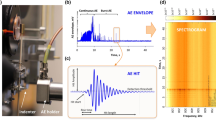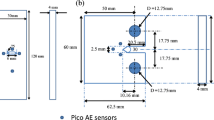Abstract
A novel experimental mechanics technique using Scanning Electron Microscopy (SEM) in conjunction with Acoustic Emission (AE) monitoring is discussed to investigate microstructure-sensitive mechanical behavior and damage of metals and to validate AE related information. Validation for the use of AE method was obtained by using aluminum alloy sharp notch specimens with different geometries tested inside the microscope and compared to results obtained outside the microscope, as well as to previously published data on similar investigations at the laboratory specimen scale. Additionally, load data were correlated with both AE information and microscopic observations of microcracks around grain boundaries as well as secondary cracks, voids, and slip bands. The reported AE results are in excellent agreement with similar findings at the mesoscale, while they are further correlated with in situ and post mortem observations of microstructural damage processes.












Similar content being viewed by others
References
Bian G, Chen Y, Hu J, Yang M (2011) Research on model of fatigue microcrack-nucleating in aluminum alloy. The Proceedings of 2011 9th International Conference on Reliability, Maintainability and Safety, pp. 416–419
Castelluccio GM, Musinski WD, McDowell DL (2014) Recent developments in assessing microstructure-sensitive early stage fatigue of polycrystals. Curr Opinion Solid State Mater Sci 18:180–187
Zhang Y, Shi H-J, Gu J, Li C, Kadau K, Luesebrink O (2014) Crystallographic analysis for fatigue small crack growth behaviors of a nickel-based single crystal by in situ SEM observation. Theor Appl Fract Mech 69:80–89
Chai G, Peng RL, Johansson S (2014) Fatigue behaviors in duplex stainless steel studied using in-situ SEM/EBSD method. Procedia Mater Sci 3:1748–1753
Akiniwa Y, Tanaka K, Matsui E (1988) Statistical characteristics of propagation of small fatigue cracks in smooth specimens of aluminium alloy 2024-T3. Mater Sci Eng A 104:105–115
Borrego LP, Costa JM, Silva S, Ferreira JM (2004) Microstructure dependent fatigue crack growth in aged hardened aluminium alloys. Int J Fatigue 26:1321–1331
McDowell DL, Gall K, Horstemeyer MF, Fan J (2003) Microstructure-based fatigue modeling of cast A356-T6 alloy. Eng Fract Mech 70:49–80
Merati A (2005) A study of nucleation and fatigue behavior of an aerospace aluminum alloy 2024-T3. Int J Fatigue 27:33–44
Zhang JZ, He XD, Tang H, Du SY (2008) Direct high resolution in situ SEM observations of small fatigue crack opening profiles in the ultra-fine grain aluminium alloy. Mater Sci Eng A 485:115–118
Zhang W, Liu Y (2012) Investigation of incremental fatigue crack growth mechanisms using in situ SEM testing. Int J Fatigue 42:14–23
Zhong Z, Ai X, Liu Z, Liu J, Xu Q (2014) Surface morphology and microcrack formation for 7050-T7451 aluminum alloy in high speed milling. Int J Adv Manuf Technol
Hazeli K, Askari H, Cuadra J, Streller F, Carpick RW, Zbib HM et al (2015) Microstructure-sensitive investigation of magnesium alloy fatigue. Int J Plast 68:55–76
Hazeli K, Cuadra J, Streller F, Barr CM, Taheri ML, Carpick RW et al (2014) Three-dimensional effects of twinning in magnesium alloys. Scr Mater 100:9–12
Hazeli K, Cuadra J, Vanniamparambil PA, Kontsos A (2013) In situ identification of twin-related bands near yielding in a magnesium alloy. Scr Mater 68:83–86
Ishihara S, Nan Z, Goshima T (2007) Effect of microstructure on fatigue behavior of AZ31 magnesium alloy. Mater Sci Eng A 468–470:214–222
Koike J, Fujiyama N, Ando D, Sutou Y (2010) Roles of deformation twinning and dislocation slip in the fatigue failure mechanism of AZ31 Mg alloys. Scr Mater 63:747–750
Boehlert CJ, Cowen CJ, Tamirisakandala S, McEldowney DJ, Miracle DB (2006) In situ scanning electron microscopy observations of tensile deformation in a boron-modified Ti–6Al–4V alloy. Scr Mater 55:465–468
Bridier F, McDowell DL, Villechaise P, Mendez J (2009) Crystal plasticity modeling of slip activity in Ti-6Al-4V under high cycle fatigue loading. Int J Plast 25:1066–1082
Chan KS (2010) Roles of microstructure in fatigue crack initiation. Int J Fatigue 32:1428–1447
Kartal ME, Cuddihy MA, Dunne FPE (2014) Effects of crystallographic orientation and grain morphology on crack tip stress state and plasticity. Int J Fatigue 61:46–58
Huda Z, Taib NI, Zaharinie T (2009) Characterization of 2024-T3: an aerospace aluminum alloy. Mater Chem Phys 113:515–517
Xue Y, El Kadiri H, Horstemeyer MF, Jordon JB, Weiland H (2007) Micromechanisms of multistage fatigue crack growth in a high-strength aluminum alloy. Acta Mater 55:1975–1984
Xue Y, McDowell DL, Horstemeyer MF, Dale MH, Jordon JB (2007) Microstructure-based multistage fatigue modeling of aluminum alloy 7075-T651. Eng Fract Mech 74:2810–2823
Yao Z, Wagoner RH (1993) Active slip in aluminum multicrystals. Acta Metall Mater 41:451–468
Khan F, Bartoli I, Rajaram S, Vanniamparambil PA, Kontsos A, Bolhassani M et al Acoustics and temperature based NDT for damage assessment of concrete masonry system subjected to cyclic loading. ed, 2014. 9063:90630B-90630B-10
Tittmann BR, Buck O (1980) Fatigue lifetime prediction with the aid of SAW NDE. J Nondestruct Eval 1:123–136
Bassim MN, Lawrence SS, Liu CD (1994) Detection of the onset of fatigue crack growth in rail steels using acoustic emission. Eng Fract Mech 47:207–214
Cuadra J, Vanniamparambil PA, Hazeli K, Bartoli I, Kontsos A (2013) Damage quantification in polymer composites using a hybrid NDT approach. Compos Sci Technol 83:11–21
Cuadra J, Vanniamparambil PA, Servansky D, Bartoli I, Kontsos A (2015) Acoustic emission source modeling using a data-driven approach. J Sound Vib 341:222–236
Meriaux J, Boinet M, Fouvry S, Lenain JC (2010) Identification of fretting fatigue crack propagation mechanisms using acoustic emission. Tribol Int 43:2166–2174
Ouyang C, Landis E, Shah SP (1991) Damage assessment in concrete using quantitative acoustic emission. J Eng Mech 117:2681–2698
Richeton T, Dobron P, Chmelik F, Weiss J, Louchet F (2006) On the critical character of plasticity in metallic single crystals. Mater Sci Eng A 424:190–195
Roberts TM, Talebzadeh M (2003) Fatigue life prediction based on crack propagation and acoustic emission count rates. J Constr Steel Res 59:679–694
Roberts TM, Talebzadeh M (2003) Acoustic emission monitoring of fatigue crack propagation. J Constr Steel Res 59:695–712
Vanniamparambil PA, Bartoli I, Hazeli K, Cuadra J, Schwartz E, Saralaya R et al (2012) An integrated structural health monitoring approach for crack growth monitoring. J Intell Mater Syst Struct 23:1563–1573
Vanniamparambil PA, Bolhassani M, Carmi R, Khan F, Bartoli I, Moon FL et al (2014) A data fusion approach for progressive damage quantification in reinforced concrete masonry walls. Smart Mater Struct 23:015007
Vanniamparambil PA, Cuadra J, Guclu U, Bartoli I, Kontsos A Cross-validated detection of crack initiation in aerospace materials, ed, 2014, 9064:906411–906429
Vanniamparambil PA, Guclu U, Kontsos A (2015) Identification of crack initiation in aluminum alloys using acoustic emission. Exp Mech
Yu J, Ziehl P, Zárate B, Caicedo J (2011) Prediction of fatigue crack growth in steel bridge components using acoustic emission. J Constr Steel Res 67:1254–1260
Jin H, Lu WY, Halda S, Bruck HA (2011) Microscale characterization of granular deformation near a crack tip. J Mater Sci 46:6596–6602
Kang J, Ososkov Y, Embury JD, Wilkinson DS (2007) Digital image correlation studies for microscopic strain distribution and damage in dual phase steels. Scr Mater 56:999–1002
Lagattu F, Bridier F, Villechaise P, Brillaud J (2006) In-plane strain measurements on a microscopic scale by coupling digital image correlation and an in situ SEM technique. Mater Charact 56:10–18
Beattie A (1983) Acoustic emission, principles and instrumentation. J Acoust Emission 2:95–128
Matthews JR (1983) Acoustic emission. vol. 2. CRC Press
Shull PJ (2002) Nondestructive evaluation: theory, techniques, and applications. CRC press
Ohtsu M, Ono K (1988) AE source location and orientation determination of tensile cracks from surface observation, NDT Int 21:143–150, 6
Toyama N, Koo JH, Oishi R, Enoki M, Kishi T (2001) Two-dimensional AE source location with two sensors in thin CFRP plates. J Mater Sci Lett 20:1823–1825
Tobias A (1976) Acoustic-emission source location in two dimensions by an array of three sensors. Non-Destructive Test 9:9–12, 2
Wang Q, Chu F (2001) Experimental determination of the rubbing location by means of acoustic emission and wavelet transform. J Sound Vib 248:91–103
Bolotin VV, Shipkov AA (2001) Mechanical aspects of corrosion fatigue and stress corrosion cracking. Int J Solids Struct 38:7297–7318
Winkler SL, Flower HM (2004) Stress corrosion cracking of cast 7XXX aluminium fibre reinforced composites. Corros Sci 46:903–915
Banerjee S, Mal AK, Prosser WH (2004) Analysis of transient lamb waves generated by dynamic surface sources in thin composite plates. J Acoust Soc Am 115:1905
Bentahar M, El Guerjouma R (2009) Monitoring progressive damage in polymer-based composite using nonlinear dynamics and acoustic emission. J Acoust Soc Am 125:EL39–EL44
Sause MGR, Gribov A, Unwin AR, Horn S (2012) Pattern recognition approach to identify natural clusters of acoustic emission signals. Pattern Recogn Lett 33:17–23
Panchal JH, Kalidindi SR, McDowell DL (2013) Key computational modeling issues in integrated computational materials engineering. Comput Aided Des 45:4–25, 1.
Allison J, Backman D, Christodoulou L (2006) Integrated computational materials engineering: a new paradigm for the global materials profession. JOM 58:25–27
May A, Belouchrani MA, Manaa A, Bouteghrine Y (2011) Influence of fatigue damage on the mechanical behaviour of 2024-T3 aluminum alloy. Procedia Eng 10:798–806
Przybyla C, Prasannavenkatesan R, Salajegheh N, McDowell DL (2010) Microstructure-sensitive modeling of high cycle fatigue. Int J Fatigue 32:512–525
Biallas G, Maier HJ (2007) In-situ fatigue in an environmental scanning electron microscope - potential and current limitations. Int J Fatigue 29:1413–1425
Moser B, Kuebler J, Meinhard H, Muster W, Michler J (2005) Observation of instabilities during plastic deformation by in-situ SEM indentation experiments. Adv Eng Mater 7:388–392
Tschopp MA, Bartha BB, Porter WJ, Murray PT, Fairchild SB (2009) Microstructure-dependent local strain behavior in polycrystals through in-situ scanning electron microscope tensile experiments. Metall Mater Trans A Phys Metall Mater Sci 40:2363–2368
Zhang W, Liu Y (2012) In situ SEM testing for crack closure investigation and virtual crack annealing model development. Int J Fatigue 43:188–196
Euh K, Lee J-M, Nam D-H, Lee S (2011) In-situ fracture observation and fracture toughness analysis of Ni-Mn-Ga-Fe ferromagnetic shape memory alloys. Metall Mater Trans A 42:3961–3968
Vanniamparambil P, Guclu U, Kontsos A (2015) Identification of crack initiation in aluminum alloys using acoustic emission. Exp Mech 1–14
Xue Y, McDowell D, Horstemeyer M, Dale M, Jordon J (2007) Microstructure-based multistage fatigue modeling of aluminum alloy 7075-T651. Eng Fract Mech 74:2810–2823
Acknowledgments
A. Kontsos would like to acknowledge the financial support received by the Office of Naval Research under the Young Investigator Program, Award #N00014-14-1-0571. He also acknowledges the technical support received under the National Aeronautics and Space Administration Space Act Agreement, No. SAA1-19439 with Langley Research Center.
Author information
Authors and Affiliations
Corresponding author
Rights and permissions
About this article
Cite this article
Wisner, B., Cabal, M., Vanniamparambil, P.A. et al. In Situ Microscopic Investigation to Validate Acoustic Emission Monitoring. Exp Mech 55, 1705–1715 (2015). https://doi.org/10.1007/s11340-015-0074-5
Received:
Accepted:
Published:
Issue Date:
DOI: https://doi.org/10.1007/s11340-015-0074-5




